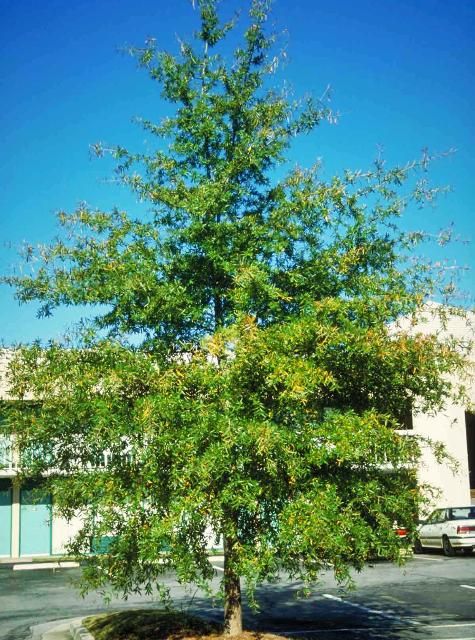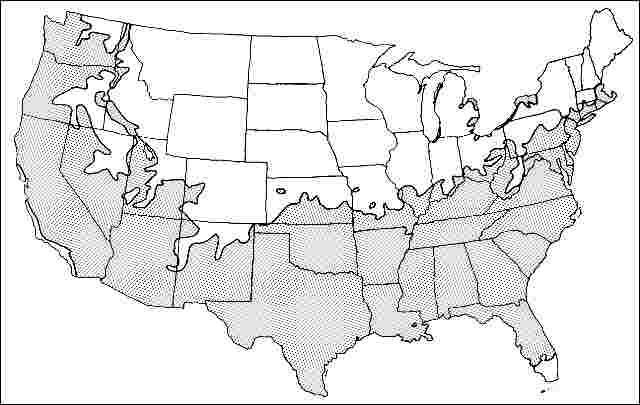Quercus phellos: Willow Oak1
Introduction
Widely used as a shade tree, in parks, and to line streets and boulevards, the fast-growing willow oak can reach over 70 feet in height with more than a 40 to 50 foot spread. The pyramidal shape in youth gives way to a rounded canopy in middle and old age, with lower branches drooping toward the ground. The long, light green willow-like leaves create dense shade and a graceful effect turning bright yellow before they fall. The tree is easy to transplant but reportedly transplants poorly in the fall.

Credit: Ed Gilman, UF/IFAS
General Information
Scientific name: Quercus phellos
Pronunciation: KWERK-us FELL-oase
Common name(s): Willow oak
Family: Fagaceae
USDA hardiness zones: 6A through 9B (Fig. 2)
Origin: native to North America
Invasive potential: little invasive potential
Uses: reclamation; sidewalk cutout (tree pit); shade; street without sidewalk; parking lot island > 200 sq ft; tree lawn > 6 ft wide; urban tolerant; highway median
Availability: not native to North America

Description
Height: 60 to 75 feet
Spread: 40 to 50 feet
Crown uniformity: symmetrical
Crown shape: pyramidal, round
Crown density: dense
Growth rate: fast
Texture: fine
Foliage
Leaf arrangement: alternate (Fig. 3)
Leaf type: simple
Leaf margin: entire
Leaf shape: lanceolate, oblong, elliptic (oval)
Leaf venation: pinnate
Leaf type and persistence: deciduous
Leaf blade length: 2 to 4 inches, 4 to 8 inches
Leaf color: green
Fall color: yellow
Fall characteristic: showy

Flower
Flower color: brown
Flower characteristics: not showy
Fruit
Fruit shape: oval, round
Fruit length: less than .5 inch, .5 to 1 inch
Fruit covering: dry or hard
Fruit color: brown
Fruit characteristics: attracts squirrels/mammals; not showy; fruit/leaves a litter problem
Trunk and Branches
Trunk/bark/branches: branches droop; not showy; typically one trunk; thorns
Pruning requirement: needed for strong structure
Breakage: resistant
Current year twig color: brown
Current year twig thickness: thin
Wood specific gravity: 0.69
Culture
Light requirement: full sun
Soil tolerances: clay; sand; loam; acidic; extended flooding; well-drained
Drought tolerance: high
Aerosol salt tolerance: high
Other
Roots: not a problem
Winter interest: no
Outstanding tree: no
Ozone sensitivity: tolerant
Verticillium wilt susceptibility: resistant
Pest resistance: resistant to pests/diseases
Use and Management
The city of Charlotte and other southern cities planted willow oak extensively during this century and it has proven to be an excellent street tree. Prune to space large branches along the trunk so they are well-attached to the tree. Willow oak forms a tight, compact head with most of the foliage on the outside of the crown. Open-grown trees would benefit from some pruning to thin the crown to develop more secondary branches along the major limbs and increase the taper on major limbs. This would improve the already good wind-hardiness of willow oak. But pruning is difficult as there are many short, spine-like twigs which are a nuisance to tree climbers. Be sure to prune out double leaders as they form, early in the life of the tree to help create a strong form.
It grows in low, bottomland wet sites of flood plains yet is drought-tolerant. It thrives in constantly wet to moist soil, although it has been known to adapt to seemingly impossible habitats. Willow oak is a tough tree well adapted to urban conditions, but can develop chlorosis of high pH soils so be sure to plant on only acid or neutral soil. Willow oak has no major problems and tolerates clay, salt, poor drainage, and compacted soil.
Root rot can be a problem in confined urban areas.
Pests
No pests are serious, but mites or scale can become troublesome.
Galls cause homeowners much concern. There are many types and galls can be on the leaves or twigs. Most galls are harmless so chemical controls are not suggested.
Scales of several types can usually be controlled with sprays of horticultural oil.
Aphids cause distorted growth and deposits of honeydew on lower leaves. On large trees, naturally-occurring predatory insects will often bring the aphid population under control.
Boring insects are most likely to attack weakened or stressed trees. Newly planted young trees may also be attacked. Keep trees as healthy as possible with regular fertilization and water during dry weather.
Many caterpillars feed on oak. Large trees tolerate some feeding injury without harm. Trees repeatedly attacked, or having some other problem, may need spraying. Tent caterpillars form nests in trees then eat the foliage. The nests can be pruned out when small. Where they occur, gypsy moth caterpillars are extremely destructive on oaks. Fall cankerworm has been a problem in some years.
Twig pruner causes twigs to drop off in the summer. The larvae ride the twig to the ground. Rake up and destroy fallen twigs.
Spider mite infested leaves first look dusty then yellowed. They can occasionally become serious on selected trees.
Lace bugs suck juices from leaves causing them to look dusty or whitish gray.
Diseases
Usually no diseases are serious.
Anthracnose may be a serious problem in wet weather. Infected leaves have dead areas following the midrib or larger veins. These light brown blotches may run together and, in severe cases, cause leaf drop. Trees of low vigor, repeatedly defoliated, may die. Trees defoliated several years in a row may need spraying, to allow the tree to recover.
Canker diseases attack the trunk and branches. Keep trees healthy by regular fertilization. Prune out diseased or dead branches.
Leaf blister symptoms are round raised areas on the upper leaf surfaces causing depressions of the same shape and size on lower leaf surfaces. Infected areas are yellowish-white to yellowish-brown. The disease is most serious in wet seasons in the spring but it does not need to be treated.
A large number of fungi cause leaf spots but are usually not serious. Rake up and dispose of infected leaves.
Powdery mildew coats leaves with white powdery growth.
Shoestring root rot attacks the roots and once inside moves upward, killing the cambium. The leaves on infected trees are small, pale or yellowed and fall early. There is no practical control. Healthy trees may be more resistant than trees of low vigor.
Chlorosis due to iron-deficiency occurs on high pH soil.


